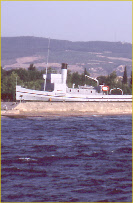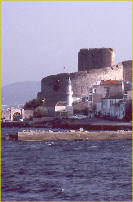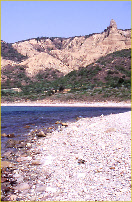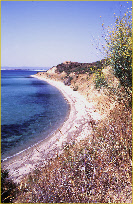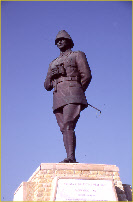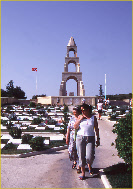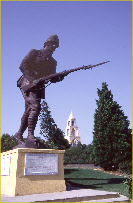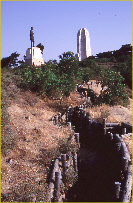Derek Tickner
© 2016 Derek Tickner

A replica of the WW1 Turkish minelayer Nusret rests on the foreshore of Canakkale, the principal town on the straits of the Dardanelles. Standing on her bridge, I take in the sweeping view across the sparkling waters to the brown hills of the Gallipoli Peninsula.
I try to imagine the events of the fateful night of March 17th, 1915, when the crew of the Nusret became national heroes. Their daring exploits were to lead to the birth of the Anzac legend and a bloody defeat for the British Empire.
After the war, Winston Churchill wrote: “During 1915, all over the Europe ... two to three millions soldiers died or were wounded, four to five thousand warships were sailing the seas ... but none of them were as effective as the Nusret and the mines she laid."
In early 1915, Churchill, then holding the political post of First Lord of the Admiralty, proposed to defeat Turkey by sailing battleships through the Dardanelles and bombarding Constantinople (now Istanbul). A powerful British and French fleet was assembled and on March 16th minesweepers cleared a path through the many mines floating in the narrow strait. The next night the Nusret audaciously ran the gauntlet of Allied ships and lay new mines.
The following day the Allied fleet launched its attack. The mines laid by the Nusret sank three battleships, with others damaged by shore batteries. The fleet limped away in retreat.
To keep the plan alive, troops would have to land on the Gallipoli Peninsula and capture the forts defending the straight. On April 5th, Admiral Fisher prophetically wrote to Churchill: “Damn the Dardanelles! They will be our grave.”
On a stinking hot August day, I climb aboard a tour bus in Istanbul and we’re driven the 300 kilometres to the Gallipoli Peninsula. My fellow sightseers are mostly young Aussie and Kiwi backpackers. The congestion of the city soon gives way to the open country road running between the azure Sea of Marmara and vivid yellow fields of sunflowers.
En route our young tour guide, Ahmet, gives a talk on the Gallipoli Campaign. When he speaks with pride of the Turkish army’s deeds, I’m struck by how little I know of the Turk’s experience of the war. They call the Gallipoli campaign ‘The Canakkale Wars’, and they celebrate a resounding victory.
The Turkish soldiers fought courageously, thwarting an invasion by a modern and well-
The Turkish soldiers were mostly illiterate peasants. For them it was a Jihad: the
true believers went straight to heaven if they died in battle against these infidels.
The Turks suffered more casualties than the Allies - the official figures are 87,000
Turkish deaths, 21,000 British, 10,000 French, 8700 Australians and 2700 New Zealanders.
The Turkish ‘butcher’s bill’ is probably much higher, as many were literally blown
to bits by the battleships’ heavy guns.
Our first stop is the Kabatepe Orientation Centre, which displays salvaged guns and munitions, photographs from 1915 and letters home from soldiers of both sides. A note scribbled in the trenches from an eighteen year old Turkish soldier to his mother poignantly describes the torment of enduring the naval bombardment. He writes that tomorrow they attack, and he will certainly die. He prays to Allah for his mother’s love and that he will do his duty. He was killed in action the next day.
A five minute drive takes us down to Anzac Cove on the western side of the peninsula. I’m surprised at just how narrow the pebble beach is. The Anzacs landed here in the early hours of April 25th, and it was the wrong beach. An unpredicted current had pushed the boats further north than their objective, codenamed Brighton Beach. The Turks spotted them; a rocket soared into the night sky and rifle flashes pricked the darkness.
The Aussies clambered onto dry land and ran unexpectedly into cliffs. They scrambled up as best they could and soon became disorientated in the tangle of ravines and bluffs that lead up to the high ground. Looking up from the beach today at the rugged topography, you can picture the confusion of those first few hours.
The Turks were equally bewildered. As dawn broke a chaotic series of skirmishes ensued in the rush for the high ground. An Australian officer and two men reached the top ridge and were able to look down over the eastern side of the peninsula to their goal, the waters of the Dardanelles.
It was at this crucial moment of the battle that Lieutenant Colonel Mustafa Kemal arrived on the heights. He’d climbed up from the eastern side, ahead of his reserve troops who were resting after a forced march. He was confronted by a party of Turkish soldiers fleeing from the Australians. In an instant Kemal realised the peril: whoever held the heights would dominate the peninsula.
He ordered the Turks to stand and fight. They protested that they had no ammunition. He commanded them to fix bayonets and lie down in a firing line. Seeing this, the Aussies dropped to the ground. Taking advantage of this lull, Kemal sent his aide running back to fetch his 57th Turkish Regiment.
It was the Anzac’s bad luck that such an outstanding commander was leading the Turkish troops at this critical time and place. If the Aussies could consolidate the ridge, they would win the day and maybe the campaign. Acting on his own initiative, Kemal committed the Turkish reserves to taking the high ground.
He was in the thick of the action, a constant inspiration to his men. He told his troops, “I don’t order you to attack, I order you to die. In the time which passes until we die other troops and commanders will take our place.”
The 57th were mown down in droves by machine guns and rifles, but the Aussies’ advance was stopped. From then on, the Turks held the high ground and could fire at will on the Anzacs in their hastily dug trenches in the gullies below.
Our party get back on the bus and drive on to Lone Pine, where we wander silently among the headstones of the cemetery, reading the terse inscriptions. A Turkish gardener beckons me over and hands me a .303 cartridge he’s just dug up. I take it with a word of thanks and am relieved to see it’s spent. Live munitions are still regularly unearthed on the battlefield.
Close by is one of the Turkish cemeteries, where row upon row of white plaques bear the names of the young conscripts who have died in the defence of their motherland. Two Turkish women, old enough to be daughters of the slain, lay fresh flowers on a grave.
The last stop of the tour is at the highest point, Chunuk Bair. Memorials to Mustafa Kemal and the Turks and New Zealanders who fought and died in the August offensive straddle the ridge. We gaze down over Shrapnel Gully, The Sphinx and The Nek to Suvla Bay and the blue waters of the Aegean Sea.
August 1915 saw the last serious Allied attempt to break the stalemate. Fresh British troops were landed at Suvla Bay to the north. After wasting a day on the beach, they too became bogged down in trench warfare. Renewed attacks by the Third Light Horse on The Nek and the British at Cape Helles to the south were bloody slaughters.
At Chunuk Bair, New Zealand and British troops captured the crucial high ground and for days fought with wave after wave of Turkish infantry. Again Kemal urged his exhausted men to keep attacking with bayonets, despite massive casualties. The watch in his chest pocket saved his life when it stopped a piece of jagged shrapnel. His tireless leadership again threw the Allies off the high ground. They were never to retake it.
Back on the tour bus, as we drive to our motel back in Canakkale, the group discusses the day’s journey. There’s a sense of awe at the sheer scale of the fighting and butchery. There’s an even greater veneration for the sacrifice made by the Diggers on this foreign shore.
And there’s a new awareness; a respect for the heroism and suffering of the young Turkish conscripts who, under inspired leadership, defeated the might of the British Empire. After the war Mustafa Kemal went on to become the first president of modern Turkey, and was honoured with the title ‘Ataturk’, the Father of the Turks.
Similarly the Turks have an admiration for the bravery of the Allies. There’s an inscription on a monument at Anzac Cove which records the words that Mustafa Kemal Ataturk wrote in 1934.
“Those heroes that shed their blood and lost their lives….you are now lying in the soil of a friendly country. Therefore rest in peace. There is no difference between the Johnnies and the Mehmets to us where they lie side by side here in this country of ours. You, the mothers, who sent their sons from far away countries, wipe away your tears. Your sons are now lying in our bosom and are in peace. After having lost their lives on this land, they have become our sons as well.”
Getting There
The Gallipoli Peninsula is a six hour drive from Istanbul. Several companies conduct escorted tours from Melbourne. Consult your travel agent or search the web for details.
Local operators run one or two day tours. Find them in the backpacker’s area of Sultanamhet in Old Istanbul. Tours also depart from Canakkale (a short ferry ride across the Dardanelles), which is served by regular buses from Istanbul.
Hire a car if you want to explore the battlefields at your own pace, but you’ll need strong nerves to handle the Turkish traffic in the city.
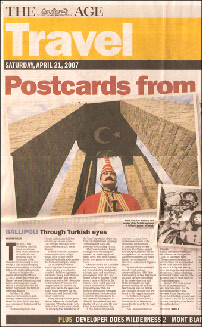
Gallipoli
Through Turkish Eyes
